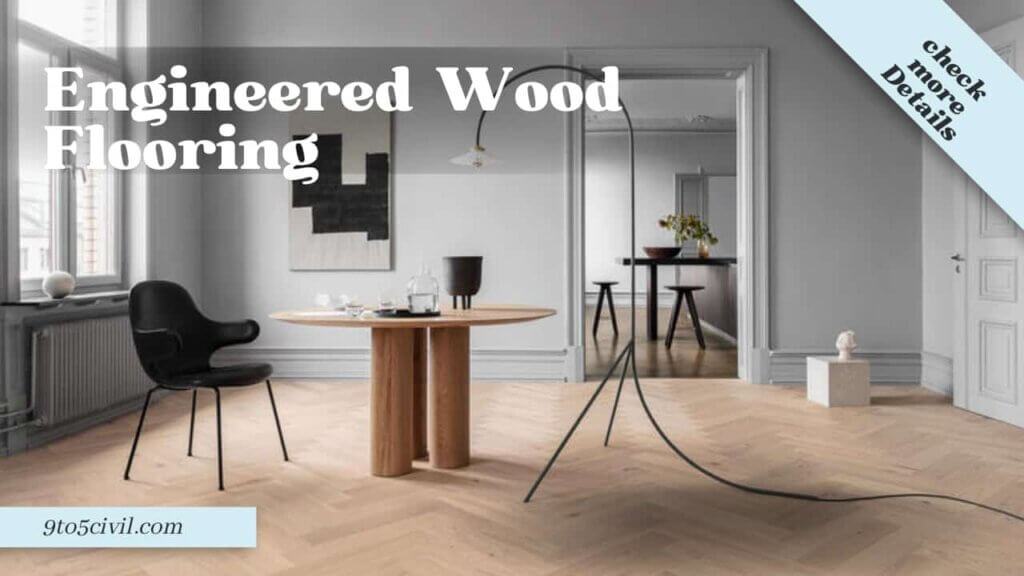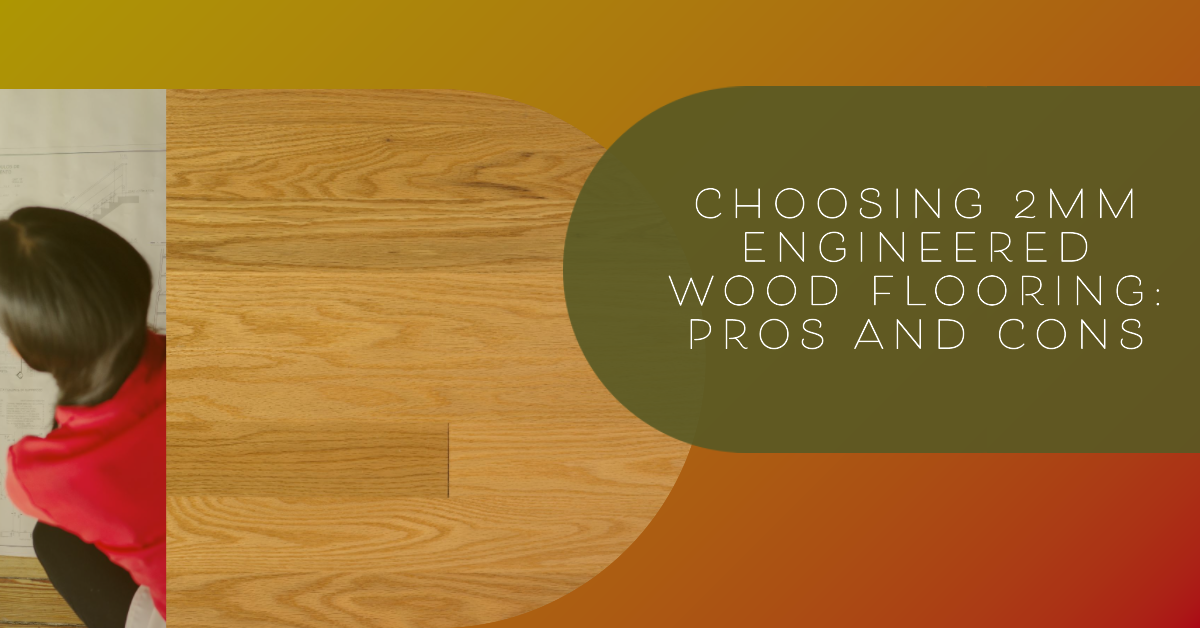Choosing the right flooring for your home is a big decision, and it can be overwhelming to wade through all the available options. Recently, I found myself in this very situation, eager to replace the worn-out carpet in my living room. After much research, I decided to go with engineered wood flooring. It seemed like the perfect compromise between the natural beauty of hardwood and the practicality of a more budget-friendly alternative. But as I delved deeper, I realized there was more to it than meets the eye. There are, in fact, both advantages and disadvantages to engineered wood flooring that you should consider before making your final choice.

Image: 9to5civil.com
This article aims to guide you through the pros and cons of engineered wood flooring, providing you with all the information you need to make an informed decision. We’ll explore what exactly engineered wood flooring is, how it compares to solid hardwood, and we’ll unpack the long-term implications of choosing this type of flooring. By the end of this guide, you’ll have a clearer picture of whether engineered wood flooring is the right fit for your home.
Understanding Engineered Wood Flooring
Engineered wood flooring, as the name implies, is a type of flooring that’s constructed through an engineering process. It’s composed of multiple layers of wood, with a thin top layer of real wood veneer that gives the flooring its aesthetic appeal. This veneer is glued onto a core made from plywood or other engineered wood products. The construction of engineered wood flooring makes it more stable than solid hardwood, especially in areas with fluctuating humidity levels.
The core layer provides strength and stability, while the veneer provides the look and feel of real hardwood. Depending on the type of engineered wood flooring, the veneer can be stained or finished to match a variety of hardwood species and colors. The construction of this type of flooring means that it’s significantly more resistant to warping, cupping, and other dimensional changes than solid hardwood. This ability to withstand fluctuating moisture and temperatures makes it a popular choice for areas prone to humidity or climate changes.
Pros and Cons of Engineered Wood Flooring
Pros
- Stability and Durability: Engineered wood flooring is less prone to warping, cupping, and shrinking than solid hardwood, making it more stable and durable. This makes it an excellent choice for areas prone to moisture fluctuations, such as basements or kitchens. Moreover, its durable nature also means it can withstand heavy foot traffic, making it suitable for high-traffic areas like hallways and living rooms.
- Installation Flexibility: Engineered wood flooring can be installed over concrete, plywood, or even existing hardwood floors, offering more flexibility than solid hardwood. This means that you may not need extensive pre-installation work on your existing subfloor, making installation potentially easier and faster. These properties also make it ideal for renovations and for adding value to your home.
- Cost-Effectiveness: Engineered wood flooring is often more budget-friendly than solid hardwood due to its construction method and use of plywood for the core layer. This makes it a more affordable option without sacrificing the look of real wood.
- Wide Range of Styles and Finishes: Engineered wood flooring is available in a vast range of styles and finishes to match any design aesthetic. You can find veneers that mimic the look of various hardwood species, including oak, maple, cherry, and walnut. You can also choose from different colors, textures, and even patterns to match your personal preferences.
- Environmentally Friendly: Engineered wood flooring can be made from sustainably harvested wood resources, making it a more eco-friendly choice than some other flooring options. This means that you can enjoy the beauty of hardwood without compromising environmental sustainability.

Image: www.woodandbeyond.com
Cons
- Limited Refinishing: Engineered wood flooring has a thin veneer, which limits the number of times it can be refinished. While you can still refinish it once or twice, you won’t be able to do it as much as you could with solid hardwood. This is an important consideration to factor into your long-term home design plans.
- Potential for Damage: The thin veneer makes engineered wood flooring more susceptible to scratches and dents than solid hardwood. Although stains and finishes can help to protect the floor, it is important to take precautions to minimize damage. To avoid long term damage, use furniture pads or felt protectors.
- Less Expensive Look: Engineered wood flooring may not have the same luxurious, high-end appearance as solid hardwood. Depending on your goals, this may mean a less high-end look, and may affect the overall impression of your home.
Engineered Wood Flooring: A Growing Trend
Engineered wood flooring has seen a surge in popularity in recent years, largely due to its multiple benefits. As home design trends move towards sustainable materials and more accessible options, engineered flooring continues to be a leading choice for homeowners. Several factors have contributed to its rise, including:
- Increased Demand for Durability: Homeowners are increasingly aware of the importance of durable flooring options that can withstand heavy traffic and changing environmental conditions. Engineered wood flooring fits this criteria perfectly.
- Growing Sustainability Movement: As consumers become more aware of the environmental impact of their choices, engineered wood flooring, especially those made from sustainably harvested wood, has become a preferred option. This is especially true in the realm of home renovations and green building practices.
- Innovative Manufacturing Techniques: Advancements in manufacturing techniques have allowed for the creation of more realistic and durable engineered wood flooring products. New technologies offer enhanced stability, scratch resistance, and water resistance, further reinforcing the appeal of this flooring option.
Expert Advice for Choosing Engineered Wood Flooring
Choosing the right engineered wood flooring for your home can be a rewarding experience. Consider the following tips to help you make a well-informed decision:
- Consider your budget and long-term needs: While engineered wood flooring is relatively affordable, it’s wise to consider your budget constraints. Factor in the cost of installation, potential refinishing, and any future replacements when making your decision.
- Research different brands: Not all engineered wood flooring is created equal. Carefully research various brands, compare their quality, warranties, and customer service. Look for brands that use sustainable forestry practices and offer responsible manufacturing processes.
- Think about your lifestyle: Consider your family’s needs and lifestyle when making your selection. If you have pets or children, you might want to choose a durable and scratch-resistant option.
- Inspect the samples: Always check the samples thoroughly before making a purchase. Examine the veneer for any irregularities or defects, and ensure the overall quality meets your expectations.
- Consult a professional: If you’re unsure about your specific needs or the installation process, it’s wise to consult with a professional flooring installer. They can provide expert advice and guidance tailored to your project. Remember, selecting the right contractor can make a significant difference in the longevity and aesthetic appeal of your project.
FAQ: Engineered Wood Flooring
Here are some frequently asked questions about engineered wood flooring:
1. How long does engineered wood flooring last?
With proper care and maintenance, engineered wood flooring can last for decades. The exact lifespan depends on factors like the quality of the product, installation, and how it’s maintained.
2. Can engineered wood flooring be refinished?
Yes, engineered wood flooring can be refinished, but only a few times due to the thin veneer. However, you can often sand and refinish the surface to restore its appearance.
3. Is engineered wood flooring waterproof?
Engineered wood flooring is not waterproof, but it is more water-resistant than solid hardwood. Some modern engineered wood flooring products are treated with water-repellent coatings to provide enhanced moisture resistance. However, it’s crucial to address spills and water leaks promptly to prevent damage.
4. Is engineered wood flooring suitable for bathrooms?
While engineered wood flooring can be used in bathrooms, it’s important to choose a waterproof or water-resistant option. You should also ensure adequate ventilation to prevent moisture buildup.
Pros And Cons Of Engineered Wood Flooring
Conclusion
Engineered wood flooring offers a blend of durability, affordability, and versatility. It presents a viable alternative to solid hardwood, especially in settings where moisture variations or budget constraints play a significant role. By understanding the pros and cons, you can make a well-informed decision that aligns with your home’s unique needs. Are you interested in exploring the features and benefits of engineered wood flooring further to see if it might be the right fit for your home?






